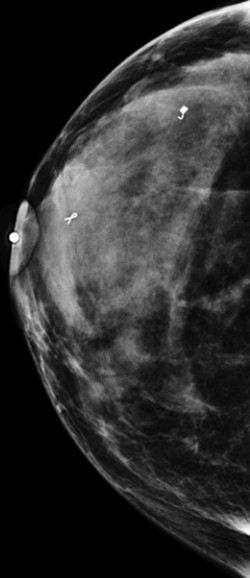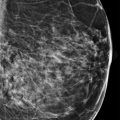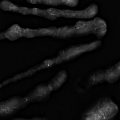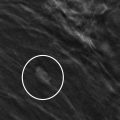Presentation and Presenting Images
( ▶ Fig. 95.1, ▶ Fig. 95.2, ▶ Fig. 95.3, ▶ Fig. 95.4, ▶ Fig. 95.5, ▶ Fig. 95.6, ▶ Fig. 95.7, ▶ Fig. 95.8, ▶ Fig. 95.9)
A 46-year-old female recently diagnosed with invasive ductal carcinoma (IDC) with lobular features of the right breast presents for diagnostic mammography and evaluation.
95.1.1 Breast Tissue Density
The breasts are extremely dense, which lowers the sensitivity of mammography.
95.1.2 Imaging Findings
The imaging of the left breast is normal (not shown). The right breast contains a ribbon clip (broken arrow) in the retroareolar location and a coil clip (solid arrow) at the 10 to 11 o’clock position ( ▶ Fig. 95.1, ▶ Fig. 95.2, ▶ Fig. 95.5, ▶ Fig. 95.6, ▶ Fig. 95.7, ▶ Fig. 95.8, and ▶ Fig. 95.9). The clips denote the sites of biopsy-proven malignancy; however, no discreet masses are seen on conventional mammography or on digital breast tomosynthesis (DBT) Additionally, there is no appreciable change since the comparison mammogram ( ▶ Fig. 95.3 and ▶ Fig. 95.4).
95.2 BI-RADS Classification and Action
Category 6: Known biopsy-proven malignancy
95.3 Differential Diagnosis
Breast cancer (invasive ductal carcinoma with lobular features): The lesions in this case were biopsied and clips placed at the site of each biopsy. Even with knowledge of the lesion location, the lesions remain occult mammographically and on DBT.
Normal study: Although the findings are not detected by mammography, this is not a normal study. This case represents cancers that remain undetected by conventional mammography or DBT.
Summation artifacts: Summation artifacts create mass lesions. DBT demonstrates that summation artifacts are the result of parenchymal overlap. This is not the case here.
95.4 Essential Facts
The pathology for this patient’s malignancy is invasive ductal carcinoma with lobular features. This likely accounts for its occult nature.
Invasive lobular carcinoma has a single file tumor growth pattern that is often very difficult to detect on breast imaging.
The ease of detection of cancers on mammography varies by tumor type. Invasive ductal carcinoma is easier to identify mammographically than invasive lobular carcinoma.
Invasive lobular carcinomas which often present as subtle asymmetries and architectural distortions are better seen with DBT than with conventional mammography.
95.5 Management and Digital Breast Tomosynthesis Principles
DBT detects and characterizes the majority of masses in women regardless of breast density.
DBT reduces breast tissue overlap effectively revealing breast lesions that may have gone undetected.
Not all masses are detected by DBT, as seen in this case.
Most breast cancers are identified on both views; however, even with DBT imaging, some cancers are well seen on only one view. Therefore, in order to identify the majority of breast malignancies, the use of two views is recommended for diagnostic imaging with DBT.
In a letter to the Radiology editor (2013), Dr. Daniel Kopans describes masses that will be undetected on both conventional and DBT imaging as masses that don’t have edges outlined by fat, that don’t distort the architecture of the breast, and that don’t make calcifications.
95.6 Further Reading
[1] Baker JA, Lo JY. Breast tomosynthesis: state-of-the-art and review of the literature. Acad Radiol. 2011; 18(10): 1298‐1310 PubMed
[2] Kopans DB. Digital breast tomosynthesis: a better mammogram. Radiology. 2013; 267(3): 968‐969 PubMed

Fig. 95.1 Right craniocaudal (RCC) mammogram.
Stay updated, free articles. Join our Telegram channel

Full access? Get Clinical Tree








